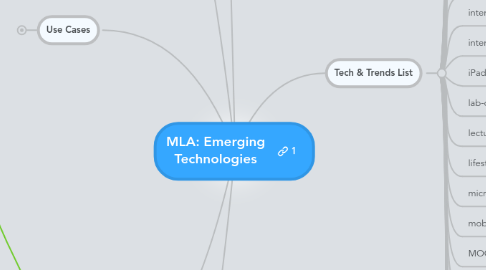
1. Use Cases
1.1. Communication
1.1.1. Social Media
1.1.1.1. Facebook
1.1.1.2. Flickr
1.1.1.3. Google Plus
1.1.1.4. Linked In
1.1.1.5. Pinterest
1.1.1.6. Twitter
1.1.1.7. Youtube
1.1.2. Videochat
1.1.2.1. Google Hangouts
1.1.2.2. Skype
1.2. Education
1.3. Publishing
1.4. Medical & Healthcare
1.4.1. 3D printing
1.4.2. Wearable tech
1.4.3. Mobile health
1.4.4. Quantified self
1.4.5. Personalized medicine
1.4.6. Personal genomics
1.5. Research/Science
2. Tech Impacts
2.1. Impact on Human Body & Behavior
2.1.1. custom design
2.1.2. rapid prototyping
2.1.3. behavior modification
2.2. Impact on Communication
2.2.1. Education
2.2.2. Marketing
2.2.3. Outreach
2.2.4. Collaboration
2.2.5. Health Literacy
2.3. Impact on Healthcare
2.3.1. Diagnosis
2.3.2. Treatment
2.3.3. Support
2.3.4. Prognosis
2.3.5. Prevention
3. Wishlist
3.1. Data citation standards that allow data sets to be cited, tracked, and utilized as part of the information life cycle.
3.2. It would be nice to develop a system for capturing and sharing intellectual capital within hospitals across all departments, and between hospital systems.
3.3. the wholistic techs that bind all the other smaller techs together - the one ring to rule them all has not emerged in EHRs or other technologies
4. ETech Discovery
4.1. blogs
4.2. books
4.3. microblogs
4.4. conferences/events
4.4.1. TED
4.4.2. Health Datapalooza
4.5. email lists
4.6. people
4.7. podcasts
4.8. reports
4.8.1. Horizon Report
4.9. social media
5. Skill Sets
5.1. Technology support
5.1.1. software applications
5.1.2. mobile apps
5.1.3. mobile devices
6. Tech & Trends List
6.1. 3d printing
6.2. apps
6.2.1. single-purpose apps
6.2.1.1. diagnosis
6.2.1.2. medical treatment
6.3. artificial intelligence
6.3.1. IBM Watson
6.4. augmented reality
6.5. automated cataloging
6.6. automated circulation
6.7. big data
6.7.1. digitised self-tracking
6.8. biofuels
6.9. biohacking
6.10. biological implant devices
6.10.1. implant sensors
6.11. bioprinting
6.12. citizen science
6.13. cloud storage
6.13.1. Box
6.13.2. Dropbox
6.13.3. Google Drive
6.13.4. File sharing
6.14. collaboration technologies/tools
6.15. communication tools
6.15.1. Facebook
6.15.2. Facetime
6.15.3. Google Hangouts
6.15.4. Google Plus
6.15.5. LinkedIn
6.15.6. Skype
6.15.7. Twitter
6.16. crowdfunding
6.17. crowdsourcing
6.18. data analysis
6.18.1. data sonification
6.18.2. data visualization
6.18.2.1. visual data analysis
6.18.2.2. #dataviz
6.18.2.3. #datavis
6.18.3. data citation
6.19. data repositories
6.20. devices
6.20.1. hybrid phone/tablet devices
6.20.2. short throw projectors
6.20.3. smartphones
6.20.4. tablet computing
6.20.4.1. iPads
6.21. diagnosis support tools
6.22. digital curation
6.22.1. Pinterest
6.22.2. Scoop-it
6.23. digitisation
6.23.1. Baidu
6.23.2. Google Books
6.23.3. institutional repositories
6.23.4. Wellcome Trust
6.24. digital storytelling
6.25. e-books
6.26. education
6.26.1. blended learning
6.26.2. flipped classroom
6.26.3. instruction delivery systems
6.26.3.1. Prezi
6.26.3.2. Slide Rocket
6.26.3.3. Slideshare
6.26.4. lecture capture
6.26.5. open education
6.26.5.1. #OER
6.26.6. tools
6.26.6.1. Blackboard
6.26.6.2. MyEd
6.27. electronic health records
6.27.1. #ehr
6.27.2. personal health records
6.27.3. #phr
6.28. flexible batteries
6.29. games
6.29.1. advocacy / activism / change
6.29.1.1. games for change
6.29.2. health
6.29.2.1. games for health
6.29.2.2. #g4h
6.29.3. learning
6.29.3.1. game-based learning
6.29.3.2. games for learning
6.29.3.3. #gbl
6.30. genetically modified meat
6.31. geocaching / geolocating
6.32. geolocating
6.33. gesture-based computing
6.34. Google Glass
6.35. hologram / 3D displays
6.36. informatics
6.36.1. altmetrics
6.36.2. bioinformatics
6.36.3. data mining
6.37. information sharing tools
6.37.1. blogs
6.37.2. instant messaging
6.37.3. podcasts
6.37.4. RSS
6.37.5. wifi
6.38. information management tools
6.38.1. such as???
6.39. intellectual property management
6.39.1. Creative Commons
6.39.2. Google Author
6.40. internet of everything
6.41. internet of things
6.42. iPads
6.43. lab-on-a-chip
6.44. lecture capture
6.45. lifestreaming
6.46. microbiome
6.47. mobile
6.47.1. mobile computing
6.47.2. mobile health
6.47.3. mobile learning
6.47.4. mobile technology
6.47.5. 4G
6.48. MOOCs
6.49. nanotechnology
6.50. NFC (Near Field Communication)
6.51. open
6.51.1. open access
6.51.2. open content
6.51.3. open data
6.51.4. open education
6.51.4.1. lecture capture
6.51.4.2. #OER
6.51.5. open learning
6.51.6. open source
6.52. participatory medicine
6.53. personalized medicine
6.54. point-of-care tools
6.55. medicine
6.55.1. genomics
6.55.2. individualized
6.55.3. participatory
6.55.4. personalized
6.55.5. translational
6.56. mind controlled devices
6.57. molecular-level enhanced nutrition
6.58. nanotechnology
6.58.1. smart pills
6.58.2. medical robotics
6.59. open source content
6.60. optical computing
6.61. personal genomics
6.62. programming languages
6.62.1. html5
6.63. QR codes
6.64. quantified self
6.65. quantum computing
6.66. reference management software
6.66.1. CiteULike
6.66.2. Colwiz
6.66.3. Endnote
6.66.4. Mendeley
6.66.5. SciRef
6.66.6. Zotero
6.67. robotics
6.67.1. da Vinci surgery
6.67.2. robotic surgery
6.67.3. robot teachers
6.67.4. social robotics
6.67.4.1. cuddle bots
6.68. salivary diagnostics
6.69. sensor equipped environments
6.69.1. Alzheimer care environments
6.69.2. digital door locks
6.70. short throw projectors
6.71. smart objects
6.71.1. near field communication
6.71.2. smart phone
6.71.2.1. braille smartphone
6.71.3. smart watches
6.71.3.1. Pebble
6.71.4. smart textiles
6.72. social learning environments
6.73. social media
6.73.1. health care social media
6.73.1.1. #hcsm
6.73.2. emergency management & disaster response
6.73.2.1. #smem
6.74. social reference management
6.74.1. Mendeley
6.74.2. RefWorks
6.74.3. Zotero
6.75. speech recognition
6.76. stem cell treatment
6.77. texting / SMS
6.77.1. professional uses
6.77.2. for reference
6.77.3. for emergency management & disaster response
6.78. translational medicine
6.79. ubiquitous computing
6.80. unmanned vehicles
6.80.1. autopilot
6.81. video
6.81.1. capture / recording
6.81.2. instruction
